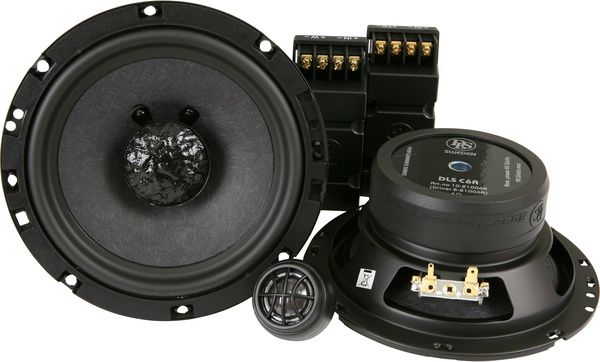DLS C6A Performance Component speakers
An interestingly well made set of components. Different because the midbass driver has a modified approach to what was sometimes called a whizzer cone. This is when a speaker driver bears a cone of material at the normal dust-dome location that looks a lot like the collar put around a dog’s neck by a vet to stop it scratching. Like an inverted lamp shade. The whizzer cone is able to raise far better and higher frequencies than the main cone and so is normally used to make horribly cheap speakers work as a single driver ‘full range source’, tweeter-less. In this case, however, the whizzer is on a quality driver and is topped by a paper pulp cap and so extends a segment of cone area (the dust dome) further out in front of the main driver whilst still affording the better reproduction of the high frequencies by the clever ‘whizzer’. This is in addition to the performance of the supplied tweeter and is described as Extended Frequency Response technology. It looks quite handsome and purposeful, too. The tweeters are high quality Silk domes and the bass and treble filters can be separated for easier installation when tweeters are placed in ‘A’ pillars and midbasses in doors. This arrangement is also one of the reasons for the EFR ‘whizzer’ design. Pressed steel chassis and rubber magnet boots.
– Woofer size: 16.5cm (6.5in)
– Tweeter: T20 20mm (0.8in) silk dome
– Power handling capacity: 60w RMS/90w max
– Frequency range: 50Hz to 20kHz
– Crossover point: 5kHz
– Sensitivity: 93dB (1W/1m)
– Outer diameter of woofer: 165mm (6.5in)
– Magnet size: 80mm (3.15in)
– Mounting depth: 63mm (2.48in)
– Size of passive crossover box: 105 x 44 x 35mm
– Mounting hole:146mm
– Impedance:4 Ohms
Review by Adam Rayner
These speakers were fitted to Tracey Elcome’s HighDown Honeyz Ford Fiesta and seen at a recent sound off. Driven by a DLS CA31 three channel amplifier with the third channel driving a KW10 woofer in a DLS designed box and with the wiring and other bits like sound deadening kit sold alongside it, the whole package is one that seems to work well, with these speakers as possibly the most crucial part.
The tweeters were mounted higher up than the midbasses in the Fiesta and the install was unfussy but definitely designed to compete on the EMMA circuit. The sound was revealing and although not like DLS’ top end mad price speakers, the signal they were getting sent was obviously of high quality and they were resolving it more than well. It was so good that it made you want more and try to see if you could get it just a bit louder. However, they were pretty easy to overload and had not yet been filtered firmly by use of the Pioneer P88RSII internal electronics when I got to try them out.
Which is just as well since I was able to take them to their limits and see how they worked. If you do overload them a bit they flap and complain easily, so they are made for audiophile use and not to run along the ragged edge of Total Harmonic Distortion using their Bollocks as brakes.
I had to wick back a little as the amplifier was a posh one with real headroom and unless you leave some headroom in your speakers’ level ability, you can find you reach the end of the line. Leave the rope’s end unfrayed though and it’s lovely. Sweet, crisp and with great detail from the silky HF and lovely placement due to the soft frequency overlap of the ERF midbass with the tweeter. A sweet and clean image results.
If what you want is quality that can go loud enough to satisfy and like your tunes with some purity, placement and detail, then they are startlingly good and work especially well with the stablemates selected for them. Not massive, not super-bass nor paragons of aural purity but together with the rest, they make a system good enough to really amaze anyone who is a disbeliever in good SQ’s very existence in-car at any price, let alone an affordable one. Scores well enough to gain a higher-up Talk Audio Best Buy flag.
Overall 9.2
Sound Quality 9
Build Quality 9
Power Handling 8
Efficiency 10
Value For Money 10

